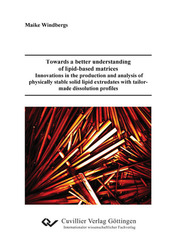| Fachbereiche | |
|---|---|
| Buchreihen (96) |
1377
|
| Nachhaltigkeit |
3
|
| Gesundheitswesen |
1
|
| Geisteswissenschaften |
2362
|
| Naturwissenschaften |
5405
|
| Mathematik | 229 |
| Informatik | 318 |
| Physik | 980 |
| Chemie | 1363 |
| Geowissenschaften | 131 |
| Humanmedizin | 243 |
| Zahn-, Mund- und Kieferheilkunde | 10 |
| Veterinärmedizin | 108 |
| Pharmazie | 147 |
| Biologie | 835 |
| Biochemie, Molekularbiologie, Gentechnologie | 121 |
| Biophysik | 25 |
| Ernährungs- und Haushaltswissenschaften | 45 |
| Land- und Agrarwissenschaften | 1004 |
| Forstwissenschaften | 201 |
| Gartenbauwissenschaft | 20 |
| Umweltforschung, Ökologie und Landespflege | 148 |
| Ingenieurwissenschaften |
1789
|
| Allgemein |
97
|
|
Leitlinien Unfallchirurgie
5. Auflage bestellen |
|
Erweiterte Suche
Towards a better understanding of lipid-based matrices – Innovations in the production and analysis of physically stable solid lipid extrudates with tailor-made dissolution profiles
Maike Windbergs (Autor)Vorschau
Inhaltsverzeichnis, Datei (48 KB)
Leseprobe, Datei (150 KB)
Solid lipid extrudates were produced by the extrusion of lipid powders and drug below their melting points to form coherent matrices in which the drug is embedded. Systematic investigations with a combination of novel and established characterization methods led to a significantly increased process understanding and improved dosage form quality.
Keyfactors for the polymorphic behaviour of lipids during extrusion could be identified. As polymorphic transitions had a strong influence on the dissolution behaviour it is of high importance to avoid those changes.
The dissolution behaviour from lipid-based matrices depended on the chain length of the fatty acids and the degree of esterification of the individual lipid. In addition, interactions between different glycerides led to unpredictable solid-state changes significantly decreasing the dissolution rate. The recrystallization behaviour of resolidified lipid melts as model systems showed the great influence of storage temperature on the rate of recrystallization.
Tailor-made dissolution profiles were obtained from extrudates consisting of various ratios of different triglycerides and a hydrophilic polymer. There was no evidence of solid-state changes in the matrix components and drug. During storage testing in accelerated conditions all processed formulations remained stable protecting the humidity-sensitive model drug against hydration.
The distribution of drug and matrix material in the core and at the surface of the extrudates was mapped with Raman microscopy. The results emphasized the importance of drug distribution on the release behaviour of matrix dosage forms as the spatial distribution due to the manufacturing technique had a higher impact on dissolution than solid-state changes of the drug.
Intrinsic dissolution testing comprising simultaneous measurement of the drug concentration in the dissolution medium (UV-VIS spectrometry) and the solid-state form of the sample (in situ Raman spectroscopy) offered deeper insight into the release characteristics from lipid-based matrices.
For the first time, in situ high-resolution visualization of solid-state characteristics and drug release of a solid dosage form was realized during dissolution testing with coherent anti-Stokes Raman scattering (CARS) microscopy and is likely to impact future applications for different kinds of solid dosage forms.
| ISBN-13 (Printausgabe) | 3869550724 |
| ISBN-13 (Printausgabe) | 9783869550725 |
| ISBN-13 (E-Book) | 9783736930728 |
| Sprache | Englisch |
| Seitenanzahl | 182 |
| Auflage | 1 Aufl. |
| Band | 0 |
| Erscheinungsort | Göttingen |
| Promotionsort | Heinrich-Heine-Universität Düsseldorf |
| Erscheinungsdatum | 05.08.2009 |
| Allgemeine Einordnung | Dissertation |
| Fachbereiche |
Pharmazie
Biochemie, Molekularbiologie, Gentechnologie |








